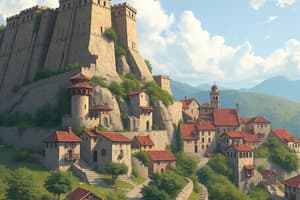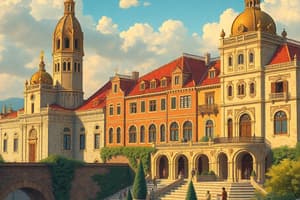Podcast
Questions and Answers
Cataluña es conocida por su fuerte identidad cultural y el idioma ______.
Cataluña es conocida por su fuerte identidad cultural y el idioma ______.
catalán
El ______ tiene tradiciones lingüísticas y culturales únicas, así como un fuerte sentido de identidad regional.
El ______ tiene tradiciones lingüísticas y culturales únicas, así como un fuerte sentido de identidad regional.
País Vasco
Galicia tiene conexiones históricas con las antiguas poblaciones ______.
Galicia tiene conexiones históricas con las antiguas poblaciones ______.
celtas
Las comunidades autónomas presentan variaciones en las actividades ______ que reflejan sus recursos naturales.
Las comunidades autónomas presentan variaciones en las actividades ______ que reflejan sus recursos naturales.
Las características demográficas, como la ______ poblacional, varían considerablemente entre las regiones.
Las características demográficas, como la ______ poblacional, varían considerablemente entre las regiones.
España está dividida en 17 comunidades autónomas, cada una con su propia historia, cultura y características __________.
España está dividida en 17 comunidades autónomas, cada una con su propia historia, cultura y características __________.
Cada comunidad tiene su propio parlamento __________, representantes locales elegidos y un gobierno regional.
Cada comunidad tiene su propio parlamento __________, representantes locales elegidos y un gobierno regional.
Las variaciones regionales en __________ y costumbres son prominentes en todas las comunidades.
Las variaciones regionales en __________ y costumbres son prominentes en todas las comunidades.
El __________ es un aspecto significativo de la identidad regional, con variaciones en dialectos y lenguas oficiales.
El __________ es un aspecto significativo de la identidad regional, con variaciones en dialectos y lenguas oficiales.
La __________ jugó un papel importante en la evolución de algunas regiones de España.
La __________ jugó un papel importante en la evolución de algunas regiones de España.
Las características __________ incluyen paisajes diversos, desde terrenos montañosos hasta regiones costeras.
Las características __________ incluyen paisajes diversos, desde terrenos montañosos hasta regiones costeras.
Las __________ y sus evoluciones han moldeado la identidad única de cada comunidad autónoma.
Las __________ y sus evoluciones han moldeado la identidad única de cada comunidad autónoma.
El clima varía entre las comunidades, influyendo en la __________, los hábitos de vida y el entorno construido.
El clima varía entre las comunidades, influyendo en la __________, los hábitos de vida y el entorno construido.
Flashcards
Autonomous Communities of Spain
Autonomous Communities of Spain
17 self-governing regions in Spain, each with its own history, culture, and geography, established under the Spanish Constitution.
Regional Identity
Regional Identity
A unique sense of belonging to a specific community, often due to distinct language, customs, and traditions.
Regional Variations
Regional Variations
Differences in traditions, customs, folklore, music, and festivals between the Spanish autonomous communities.
Reconquista
Reconquista
Signup and view all the flashcards
Regional Languages
Regional Languages
Signup and view all the flashcards
Spanish Constitution
Spanish Constitution
Signup and view all the flashcards
Territorial Characteristics
Territorial Characteristics
Signup and view all the flashcards
Historical Development
Historical Development
Signup and view all the flashcards
Catalonia
Catalonia
Signup and view all the flashcards
Basque Country
Basque Country
Signup and view all the flashcards
Galicia
Galicia
Signup and view all the flashcards
Autonomous Regions
Autonomous Regions
Signup and view all the flashcards
Regional Economies
Regional Economies
Signup and view all the flashcards
Study Notes
Autonomous Communities of Spain: Culture, History, and Territory
- Spain is divided into 17 autonomous communities, each with its own unique history, culture and geographical features.
- These communities are established under the Spanish Constitution, providing a degree of self-governance over a range of matters.
- Each community has its own regional parliament, elected local representatives, and a regional government.
- Regional identity and variations in language, customs, and traditions are prevalent.
- The history of each community is distinct, reflecting factors like Roman occupation, medieval kingdoms, and the evolution of local traditions.
Cultural Diversity
- Regional variations in traditions and customs are prominent. This includes folklore, music, festivals, dances, and cuisine.
- Many communities have preserved traditions passed down through generations.
- Language is a significant aspect of regional identity, with variations in dialects and official languages. Spanish is the common language, but Catalan, Basque, Galician, and other regional languages are also spoken and recognized.
Historical Background
- The historical development of each community is shaped by its geographical location and interactions with neighboring areas and nations.
- This includes the impact of different empires and cultures (e.g., Roman, Visigothic, Islamic).
- The Reconquista, a period in Spain's history, played a significant role in the evolution of some regions.
- The development of local kingdoms and independent entities influenced the cultural and political trajectory of these communities.
- Each community's history demonstrates unique experiences like periods of prosperity, struggles, and conflicts.
Territorial Characteristics
- Regional variations include diverse landscapes, from mountainous terrains to coastal regions, deserts, and plains.
- Geographic features like mountains, rivers, and coastlines play a role in regional development and identity.
- Climate conditions vary across communities, influencing agriculture, lifestyle habits, and the built environment.
- Geographic boundaries and their evolution through historical periods have shaped the unique identity of each community.
- Densely populated regions often contrast with sparsely populated ones, resulting in unique cultural traits and economic structures.
Examples of Autonomous Communities (Illustrative)
-
Catalonia: Known for its strong cultural identity, Catalan language, and historical role in Spanish history. (Illustrative example of a major one)
-
Basque Country: Unique linguistic and cultural traditions, distinctive traditions, and a strong sense of regional identity.
-
Galicia: Historical connections to early Celtic populations, its own language (Galician), and a rich cultural heritage influenced by the Atlantic Ocean.
-
Variations in economic activities across the autonomous communities also exist, reflecting the natural resources, historical development, and industrial heritage of each area.
-
Some have strong agricultural sectors, while others are predominantly industrial or tourist destinations.
-
Industrial heritage has left its mark on certain locations and has affected their economy and social structures.
-
Demographic characteristics, like population density, vary substantially between regions.
Studying That Suits You
Use AI to generate personalized quizzes and flashcards to suit your learning preferences.




